Nebraska Grazing Conference
Do you want to learn more about grassland management and productivity, as well as conservation? Make plans now to attend the Nebraska Grazing Conference in Kearney at the Younes Convention Center Monday through Wednesday, Aug. 9-11.
A preconference tour on Monday, Aug. 9 in the afternoon at Larsen Land and Livestock, near Lexington, kicks off this year’s conference activities. Discussion topics include conservation practices, grazing management, prescribed burning and plant identification.
Sessions on Tuesday, Aug. 10 feature speakers presenting information on grazing lands topics related to conservation, the value of pollinators in grassland habitat and managing wet meadows.
On Tuesday evening, we will host a Zoom webinar panel on Grassland Carbon Credits and Markets. Scheduled speakers are Greg Ibach, Dave Aiken and Roric Paulman.
The conference will conclude on Wednesday, Aug. 11 with sessions on grazing systems and risk management.
Sponsor and exhibitor booths will showcase new programs, equipment and products to conference participants.
We look forward to seeing you in person on Aug. 9-11 at the Younes Convention Center in Kearney.
More specific info on the conference is available on the Center for Grassland Studies website.
Summer Weed Control in Alfalfa
By Brad Schick
When soil moisture is available after a cutting of alfalfa, the grasses and weeds will grow just like their name suggests: like weeds. How can these plants be held at bay?
Thick alfalfa stands will be the first defense against foxtail, crabgrass, pigweed, etc. A good fertility plan to keep stands thick will go a long to reducing weeds. Sandy soils with pH levels above 7.2 may benefit from sulfur application. Conversely, if your alfalfa field pH falls below 6.7, then liming may be needed to prevent sharp yield drops.
Delaying alfalfa harvest until the next shoots are beginning to appear at the crown may be another option to suppress weed growth. This allows the alfalfa to grow back a bit more quickly after harvest and be more competitive. Unfortunately, this means that the quality of the cutting will be lower since the plants will be more mature.
One more option is the herbicide route. With Roundup Ready varieties, Roundup can be used. In conventional varieties, grass control can be achieved using Select Max, Poast or Arrow if the grasses are less than four inches tall. If broadleaf control is needed, Pursuit or Raptor can be used on established alfalfa before the regrowth has three inches of new growth. These will set back alfalfa, and the Pursuit label says it cannot be fed, grazed or harvested for 30 days after application.
Weed problems in summer can be taken care of with herbicides, but shooting for a thick, robust stand will contribute to yield and weed control.
Fall Oats
It’s almost August and fall is just around the corner. Could you use some extra pasture or hay in late September and October? Oats might be your answer.
Oats may be one of our most underused fall forages. It grows fast, thrives under cool fall conditions, has good feed value, and can produce over two tons of hay or pasture yet this year. Plus, it dies out over winter, so it protects soil without causing planting problems next spring.
Oats also play well with others. Need a bit of spring growth? Mix in some winter small grains like cereal rye, wheat or triticale. They won’t produce much fall growth but can provide early grazing next spring. Want a high-quality grazeable forage in the late fall/early winter? Select a long season oat that won’t go to seed and add in a brassica like a turnip or forage rapeseed. Oat-brassica mixes can produce large amounts of forage in the fall, then hold quality well into the middle of winter even when they aren’t green.
To plant oats, drill about three bushels of oats per acre in early August for maximum yield potential. A fully prepared seedbed usually is best, but you can plant oats directly into weed-free wheat stubble or other crop residues when soil moisture is available. Avoid fields with herbicide carryover. For an added boost, topdress 40 pounds of nitrogen per acre unless the previous crop was heavily fertilized.
With good moisture, oats will be ready to graze about six to eight weeks after emergence. Calves and yearlings can gain over two pounds per day. Consider supplementing with magnesium to avoid grass tetany on lush oat pasture, and don't suddenly turn livestock out on oat pasture if they have been grazing short or dry pastures. Sudden respiratory and digestive problems can occur.
For hay, cut oats soon after plants begin to dry out following a killing freeze, or cut earlier if plants reach a desirable growth stage. Oats can accumulate nitrates, so test hay before feeding.
If you have good soil moisture, give fall oats a try. Some of your best forage growth may still be ahead of you.

